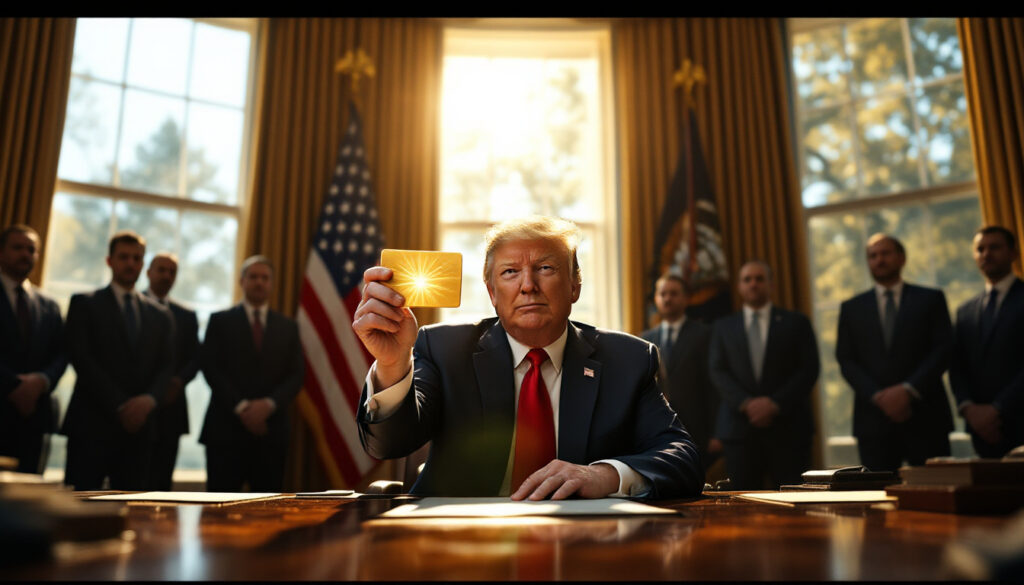What is the Trump Gold Card Visa Scheme?
Former President Donald Trump announced a new immigration pathway on February 25, 2025, that’s generating both interest and controversy. The “Gold Card” visa program requires a $5 million ($7.89 million AUD) payment directly to the US government, providing permanent residency and a path to citizenship for wealthy individuals.
The program, set to launch by mid-March 2025, represents a significant departure from traditional US immigration pathways by prioritizing direct financial contribution over other qualifying factors. Trump has positioned the program as a deficit-reduction measure, targeting the nation’s $839 billion ($1.32 trillion AUD) shortfall.
“We’ll sell maybe a million of these cards,” Trump declared during the Oval Office signing ceremony, suggesting the program could generate an unprecedented $5 trillion in revenue. The ambitious projection has raised eyebrows among immigration and economic experts.
Definition and Basic Structure
The Gold Card offers permanent residency status (equivalent to Green Card privileges) with a streamlined path to US citizenship. Unlike other visa categories, applicants need only submit the $5 million payment rather than demonstrating family connections, employment qualifications, or humanitarian need.
US Commerce Secretary Howard Lutnick, speaking in support of the program, emphasized its straightforward approach compared to existing investor visa pathways. The application process is expected to involve standard background checks, though specific security concerns in immigration remain undefined.
The program’s announcement came as the administration intensified deportation efforts targeting what it describes as “illegal aliens,” creating a stark contrast between immigration enforcement and this new pathway for the wealthy.
Key Features and Benefits
The Gold Card’s most distinctive feature is the exemption from US taxes on income earned outside American borders. This provision appears designed to attract global high-net-worth individuals who maintain significant international revenue streams.
“It’s for people of wealth or people of great talent,” Trump explained, suggesting the program targets not just the ultra-wealthy but potentially accomplished professionals, artists, and entrepreneurs.
Unlike the existing EB-5 investor visa program, Gold Card recipients aren’t required to invest in American businesses or create jobs—eliminating what Lutnick described as a system “full of nonsense, make-believe and fraud.”
The emphasis on direct government payment rather than economic stimulation through investment represents a fundamental shift in American immigration philosophy, prioritizing immediate fiscal impact over long-term economic development.
How Does the Gold Card Compare to Existing Visa Programs?
The Gold Card proposal stands in stark contrast to America’s longstanding EB-5 investor visa program, which has different requirements and objectives. Understanding these differences provides context for evaluating the potential impact of Trump’s new initiative.
Current US Investor Visa Program (EB-5)
The existing EB-5 program requires approximately $1 million ($1.57 million AUD) investment directly into American companies, with a mandate to create at least 10 jobs for American workers. This structure was designed to stimulate economic growth while providing immigration opportunities.
Approximately 8,000 people obtained EB-5 visas in the year ending September 30, 2022, generating substantial investment in American businesses. However, the program has faced criticism for lax oversight and potential abuse.
Commerce Secretary Lutnick didn’t mince words when describing the current system as “full of nonsense, make-believe and fraud,” highlighting the administration’s dissatisfaction with existing investor immigration pathways.
Unlike the Gold Card, EB-5 requires sustained business engagement and job creation metrics, creating accountability measures for visa holders. The $5 million Gold Card payment, while higher, eliminates these ongoing compliance requirements.
Golden Visa Programs Worldwide
More than 100 countries have implemented “golden visa” or investor residency programs, with varying requirements, benefits, and security protocols. Notable examples include Spain, Greece, Malta, Portugal, and Canada.
Several European nations, including the UK in 2022, have terminated their investor visa programs citing security concerns and limited public benefit. The European Commission’s 2019 report specifically identified security vulnerabilities in member states’ global golden visa programs.
Australia recently ended its significant investor visa program under the Albanese government, though Opposition Leader Peter Dutton has indicated he would reintroduce a similar scheme if elected.
The global trend appears to be moving away from such programs due to security concerns, making Trump’s introduction of the Gold Card somewhat counter to international direction. However, the program’s simplicity and direct government payment structure distinguish it from many international counterparts that require business investment or property purchase.
What Are the Security Concerns with Gold Card Visas?
The proposed Gold Card program has raised significant security questions among immigration experts, particularly regarding the verification of applicants’ wealth sources and potential exploitation by criminal elements.
Potential for Criminal Exploitation
Experts warn that rapid-pathway residency programs can inadvertently import organized crime when proper vetting procedures aren’t established. The Gold Card’s emphasis on payment over other qualifications potentially increases these risks.
Former Australian immigration official Abul Rizvi notes the particular challenge of verifying legitimate fund sources from countries like Russia and China, where financial transparency may be limited and government connections can obscure money origins.
“The difficulty of determining whether the money is coming from legitimate sources or not is immense,” Rizvi explained. This verification challenge lies at the heart of security concerns surrounding the program.
The UK terminated its golden visa program in 2022 specifically to prevent Russian oligarchs from exploiting the system amid growing tensions over the Ukraine invasion. This precedent suggests similar risks could affect the US program without robust vetting processes.
Russian Oligarch Access
Trump’s confirmation that Russian oligarchs could “possibly” use the program has intensified scrutiny. The president described some Russian oligarchs as “very nice people,” raising questions about potential conflicts of interest.
Dr. Emma Shortis from the Australia Institute noted the program represents evidence that “Trump and the broader Trump movement is ideologically aligned with Putin’s Russia,” suggesting geopolitical considerations beyond immigration policy.
These comments come amid broader concerns about the Trump administration’s strengthening relations with Russia, adding a layer of geopolitical complexity to what might otherwise be viewed as purely an immigration or economic initiative.
Security experts point to the need for enhanced cooperation with international financial intelligence units to properly vet applicant wealth sources—particularly from regions with documented histories of corruption or sanctions evasion.
How Could the Gold Card Impact US Immigration Policy?
The Gold Card proposal represents a potential paradigm shift in American immigration philosophy, creating distinct pathways based primarily on wealth rather than other qualifying factors.
Contrast with Other Immigration Initiatives
The juxtaposition of the Gold Card announcement with the administration’s accelerated deportation of individuals described as “illegal aliens” has not gone unnoticed by policy analysts. This creates what immigration scholars describe as a two-tier system explicitly differentiated by financial capacity.
While traditional immigration pathways emphasize family connections, humanitarian need, or specific employment skills, the Gold Card elevates financial contribution as the primary qualifying factor. This represents a significant departure from historical American immigration principles.
The program effectively monetizes citizenship in ways previously unseen in US policy, raising fundamental questions about the values underpinning the immigration system. Critics argue this approach commodifies American residency while supporters cite the fiscal benefits.
Conservative immigration advocates have largely supported the initiative, framing it as prioritizing immigrants who won’t require public assistance and who bring immediate economic impact of immigration policy.
Corporate Interest and Implementation
Trump explicitly mentioned that major ivy league colleges and tech giants like Apple would show interest in the program, suggesting it partially aims to address corporate demands for talent acquisition pathways.
Companies like Tesla, SpaceX, and Amazon could potentially benefit from streamlined immigration processes for key international personnel, though the high price point limits accessibility to only the wealthiest individuals or corporate-sponsored applicants.
Dr. Shortis suggests the program is designed “in the interests of Trump and a very small group of very powerful men,” questioning whether broader economic benefits would materialize beyond the initial payment.
Immigration policy analysts note the program could significantly alter the demographic profile of legal immigrants if implemented at scale, potentially reducing diversity in the immigration system by limiting access to those with substantial financial resources.
What Do Experts Say About the Gold Card Program?
Economic and immigration specialists have offered varied perspectives on the Gold Card proposal, highlighting both potential benefits and significant concerns.
Economic and Fiscal Impact
The immediate influx of funds to US government coffers represents the most obvious benefit, with each approved application generating $5 million in revenue without requiring additional federal spending.
Questions remain about whether the projected million cards is realistic given the high price point. For comparison, existing golden visa programs worldwide typically attract thousands—not millions—of applicants annually.
Abul Rizvi, a former Australian immigration official, notes both advantages and disadvantages: “The advantage is you get people with money who are spending a lot of money and paying a lot of taxes. The disadvantage is that you import a lot of organized and undetected crime.”
Economists suggest that beyond the direct payment, wealthy immigrants typically create economic activity through consumption, investment, and potentially employment generation—though these secondary benefits are more difficult to quantify.
Critical Perspectives
Dr. Emma Shortis describes the program as “Trump all over” with money being “the language he speaks,” suggesting the initiative aligns with the former president’s business-oriented approach to governance.
Immigration policy specialists question whether deficit reduction is the true motivation, pointing to potential political benefits of appealing to business interests while simultaneously pursuing restrictive policies for other immigrant groups.
The UK government previously concluded that its golden visa program “primarily benefits the investors rather than the UK,” raising questions about whether America’s Trump Gold Card overview would demonstrate different outcomes.
Security experts emphasize the need for proper vetting procedures, particularly given the high-profile nature of the program and its potential to attract politically connected individuals from countries with adversarial relationships to the United States.
FAQ: Trump’s Gold Card Visa Program
How much does the Trump Gold Card cost?
The Trump Gold Card requires a payment of $5 million USD (approximately $7.89 million AUD) to the US government.
Who can apply for the Trump Gold Card?
Wealthy individuals, including foreign investors and potentially Russian oligarchs, can apply. Trump has indicated it’s for “people of wealth or people of great talent.”
How does the Gold Card differ from existing visa programs?
Unlike the current EB-5 program that requires direct investment in US businesses, the Gold Card payment goes directly to the US government to reduce the national deficit. It also exempts holders from taxes on foreign-earned income.
When will the Gold Card program be implemented?
President Trump indicated the program would be underway by mid-March 2025, following the February 25th announcement.
What are the main criticisms of the Gold Card program?
Critics highlight security concerns, potential for criminal exploitation, difficulty verifying legitimate sources of funds, and questions about whether it primarily benefits the US or just wealthy immigrants. There are also concerns about creating a two-tier immigration system based explicitly on wealth.
Ready to Catch the Next Major ASX Mineral Discovery?
Don’t miss out on potentially market-moving mineral discoveries announced on the ASX. Visit Discovery Alert’s discoveries page to see how historic discoveries generated substantial returns, and start your 30-day free trial today to receive real-time alerts powered by our proprietary Discovery IQ model.




